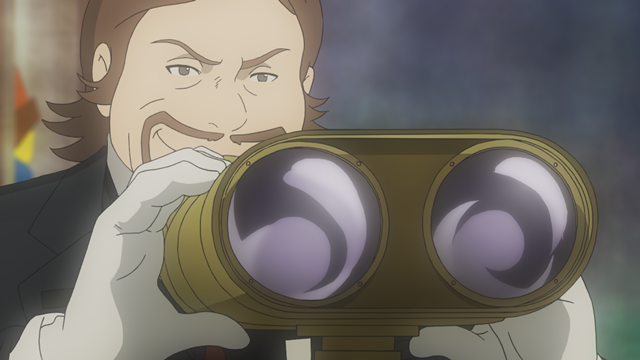Review: Part 6 “Episode 3 ~ Adventure Along The (Bogus) Transcontinental Railroad”
Welcome to our episode review of Lupin III: Part 6!
Our review is from the perspective of a “hardcore” Lupin III fan, who has seen every episode, film, and special the series has had to offer since its animated inception in 1969. The author's perspective on modern anime however, is lacking. When it comes to anime, we exclusively watch Lupin III, so cannot compare it to other shows on the market. Instead, we can only compare it with Lupin media of the past.
We will be watching the Japanese language dubbed version made available via the HIDIVE streaming platform.
Be aware that there are SPOILERS ahead.
Please only read on if you either have seen the episode already, or do not mind learning about important character interactions and pivotal plot points in advance.
“Episode 3 ~ Adventure Along The (Bogus) Transcontinental Railroad” is the first one-shot storyline to feature in Lupin III: Part 6, and the gang embark on a goofy heist adventure that unfortunately heads off the rails.
Lupin and company have their eyes set on a new target, a treasure said to be worth more than the Mona Lisa. This consists of none of the usual suspects — jewels, diamonds, crowns, and so forth. Instead, our thieves are hunting the first-ever train ticket sold within the United Kingdom, a fitting prize for any British heist flick!
This rather special proof of admission, which covered a short trip between Manchester and Liverpool, is kept hidden on the estate of an eccentric train enthusiast. Not only is the ticket stored within a rather curious room, filled to the brim with moustachioed safes, but the estate is also home to a brand-new automated train line. The private line whizzes between a series of mock locations based on famous countries within the enthusiast’s enormous garden, and is about to be unveiled to the public for the first time.
The gang feature in a mix of drama and comedic scenes here, with some excellent self-aware Lupin gags peppered in. Ultimately, however, the story feels rushed — there's a mess of characters on the estate, and the twenty-minute episode does not give us enough time to become acquainted with them all properly. As a result, many come across as needless, barely contributing towards the episode despite their screen time.
This is a surprising conclusion to reach, when considered that the story is guest-written by Masaki Tsuji.
Masaki Tsuji is an award-winning screenwriter, and a prominent figure in the Japanese TV, film, and animation industry. He has worked on many series, including (but not limited to): Astro Boy, Kimba the White Lion, Princess Knight, Unico, Devilman, Cyborg 009, Cutie Honey, Tiger Mask, Star of the Giants, Triton of the Sea, Dororon Enma-kun, The Star of Cottonland, Dr. Slump and Honey Honey.
At eighty-nine years of age, his activity as a screenwriter has understandably slowed within the past twenty years, with his last credited role being on the 2015 superhero themed animated series, Concrete Revolutio: Superhuman Phantasmagoria.
Part 6 marks his first involvement in the Lupin III franchise and after working on over one hundred different animated series, most of which aired in the 1970s — 1980s, it's impressive that it took this long for the two to cross paths!
For episode three, Masaki has drawn light inspiration from the American crime fiction novels / short stories Ellery Queen, written by two cousins, Frederic Dannay and Manfred Bennington Lee.
The stories star titular character Ellery Queen, a fictional mystery writer living in New York that aids his father in getting to the bottom of various troublesome murder cases. More than thirty novels feature Ellery Queen, and each provide readers with many twists and turns before reaching their dramatic conclusion (as all good mystery novels do)! As a result, the series remained one of the most popular pieces of mystery writing in America between 1929 and 1971.
Three characters in the episode are named as a rather obvious nod to this source material — the two thirsty wannabe detective cousins (named after the authors) and their guardian, Inspector Queen (a nod to the novels’ protagonist).
The plot however draws little parallel to the original material. Rather than including a fair “whodunnit” style of mystery writing, instead, a murder happens on the estate and the viewer knows who is responsible right away. There’s no clever twists and turns, like in Ellery Queen, as episode three remains a comedy through and through — a missed opportunity, in our opinion.
Lupin's role in the episode is confusing.
Our hero thief spends much of his screen time running around, escaping mobsters by fleeing on a pony. Fujiko Mine does most of the heavy lifting when it comes to actual thievery, cracking the “safe”, eluding the mobsters and hiding the treasure — at least, until she gets caught. The two cousins and their guardian, Inspector Queen, also lack meaningful contribution other than to hog screen time. In addition, there’s a little girl that also becomes involved somehow… we still cannot quite work out why, or how.
The plot feels the need to over-explain itself at the half-way point, during a scene with Lupin and Zenigata running side-by-side. Both the storytelling and animation work here feels sloppy, and cheapens the overarching plot.
It is a mess, and the only saving grace is the dialogue between the Lupin gang.
Lupin and company’s synergy is excellent, and a much-needed pillar throughout this rather redundant one-shot episode.
Masaki shows that he understands how to confidently write the recurring characters, and includes a nice balance of comedy, action and heartfelt dialogue that will no doubt please long-time fans.
One notable scene features Jigen Daisuke and Goemon Ishikawa XIII, after self-admittedly “fitting right in” to a costume party (despite not wearing a costume…). The pair escape Zenigata’s arrest by quickly swapping on and off disguises, in a manner that can only be described as second nature to them. Zenigata, of course, falls for the trick.
It is delightfully self-aware, and while tonally different to their writing in episodes one and two, helps show how versatile these characters can be.
The action sequence during the episodes climax is fun, and includes Jigen saving the day with style.
There’s some excellent dialogue from Fujiko, in which she decides to give up chopping off her hair to instead leave her life in the hands of her “friends”. It’s a rare moment where we see some nice appreciation of the boys from Fujiko, and the crew feel very comfortable together as a result. They’re professional partners, who clearly trust each extensively.
While not meeting expectations, episode three is mostly just harmless fun.
We do not wish to critise Masaki Tsuji too harshly, especially considering his age and incredible contributions to the animation industry over the years. We just cannot help but feel he tried to achieve too much here. The plot could have benefit from some cast members getting cut from the picture, and with a more streamlined focus between the gang, the mobsters, and their heist.
There are some nice moments involving character dialogue and a couple of neat action scenes, which are wrapped up in a stellar remix of Wild Crisis by Yuji Ohno, but it is by no means an essential watch. Coming straight off the back of the dramatic conclusion of episode two, and after considering it is the first guest-written episode of Part 6, we expected more from this.









